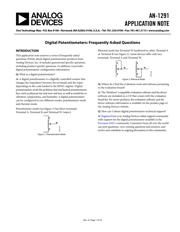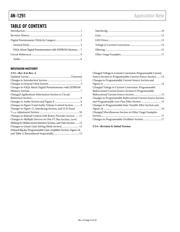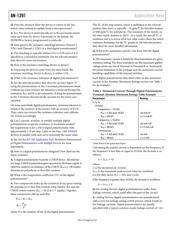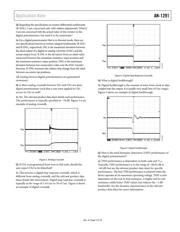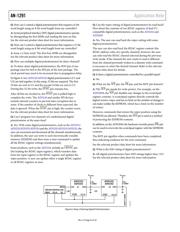Datasheet 搜索 > 数字电位器 > ADI(亚德诺) > AD5162BRMZ100-RL7 数据手册 > AD5162BRMZ100-RL7 其他数据使用手册 3/18 页
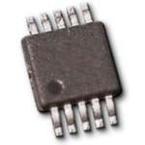
 器件3D模型
器件3D模型¥ 7.458
AD5162BRMZ100-RL7 其他数据使用手册 - ADI(亚德诺)
制造商:
ADI(亚德诺)
分类:
数字电位器
封装:
MSOP-10
描述:
双通道, 256位, SPI数字电位计 Dual, 256-Position, SPI Digital Potentiometer
Pictures:
3D模型
符号图
焊盘图
引脚图
产品图
页面导航:
原理图在P8
技术参数、封装参数在P4
型号编号列表在P4
导航目录
AD5162BRMZ100-RL7数据手册
Page:
of 18 Go
若手册格式错乱,请下载阅览PDF原文件

Application Note AN-1291
DIGITAL POTENTIOMETER FAQs BY CATEGORY
GENERAL FAQs
Q: Is there a recommended power-up sequence?
A: Yes. The relevant product data sheet provides a recommended
start-up sequence to refer to before powering up the device.
Generally, it is good practice to power the V
DD
pin first and
the V
SS
pin second. The order of the voltages at Terminal A,
Terminal B, and Terminal W (V
A
, V
B
, and V
W
, respectively) is
not important, but power these last.
There are ESD protection diodes between the V
DD
pin and
Terminal A, Terminal B, and Terminal W. For example, the
cathode of one of the diodes connects to the V
DD
pin and the
anode connects to Terminal A. As a result, any voltage occurring
at Terminal A before the V
DD
pin forward biases the diode and
powers the V
DD
pin.
For some of the digital potentiometers, power the digital signals
after the V
DD
pin. This power sequence is documented in the
relevant product data sheet.
Q: Are all digital potentiometers limited to |5 V|?
A: No. A wide portfolio of digital potentiometers are available
to handle large unipolar and bipolar power supplies. See the
Choosing the Correct digiPot for Your Application online
brochure for an up to date product list.
Q: Do digital potentiometers handle bipolar and ac operations?
A: Yes. Analog Devices offers digital potentiometers with dual
±2.5 V, ±5 V, or ±15 V supplies that can handle bipolar or ac
operation. The user can still achieve ac operation with a single
dc supply by raising the dc offset. Terminal A, Terminal B, and
Terminal W have no polarity constraints with respect to one
another.
Q: For dual-supply digital potentiometers, if V
DD
and V
SS
are
+2.5 V and −2.5 V, respectively, can digital inputs be fed from a
standard 3.3 V complementary metal-oxide semiconductor
(CMOS) logic component without logic level translation? What
are the logic level thresholds when V
DD
is +2.5 V and V
SS
is −2.5 V?
A: When using a bipolar ±2.5 V digital potentiometer, the
maximum digital supply is limited to V
DD
+ 0.3 V or V
LOGIC
+ 0.3 V.
Otherwise, the internal protection diodes clamp the voltage and
are damaged. See the relevant product data sheet for more details
on digital potentiometer levels.
Q: Is there a dependency between the logic level and power
consumption?
A: Yes. If the logic level is lower than the logic supply (V
DD
or
V
LOGIC
, if available), the input gates do not switch completely
and the device consumes more power.
Q: Why replace a mechanical potentiometer with a digital
potentiometer?
A: There are a few advantages to using a digital potentiometer
vs. a mechanical potentiometer, namely
• Higher resolution
• More reliability
• Better stability
• Faster adjustment
• More functions
• Better dynamic control
However, a digital potentiometer is not a direct replacement
for a mechanical potentiometer. See the Is a digital potentiometer a
real replacement for a mechanical potentiometer, or are there
restrictions regarding voltage potentials? question for more
information.
Q: Is a digital potentiometer a real replacement for a mechanical
potentiometer or are there restrictions regarding voltage potentials?
A: A digital potentiometer is not an exact replacement for a
mechanical potentiometer. V
A
and V
B
must not be greater than
V
DD
or less than V
SS
(or GND if the device does not have a V
SS
pin).
For example, if the desired V
A
and V
B
are +2 V and −2 V,
respectively, V
DD
must be less than, or equal to, +2 V, and V
SS
must be greater than, or equal to, −2 V.
See the AN-1121 Application Note, Replacing Mechanical
Potentiometers with Digital Potentiometers, for more
information on this topic.
Q: For digital potentiometers without nonvolatile memory,
what is the state during power-up?
A: Most Analog Devices digital potentiometers (with the notable
exception of the AD8400/AD8402/AD8403) contain power-on
reset (POR) circuitry, which presets the wiper to terminal resistance
to the middle value of the terminal to terminal resistance. For
example, if the end to end resistance (R
AB
) = 10 kΩ, at power-up,
R
WB
= R
WA
= 5 kΩ, where R
WB
is the resistance between Terminal W
and Terminal B and R
WA
is the resistance between Terminal W
and Terminal A. For the digital potentiometers that do not have
this feature, the wiper to terminal resistance can be anything at
power-up. See the relevant product data sheet for more details.
Q: Is there a particularly low power digital potentiometer?
A: Yes. The AD5165 is an Analog Devices product that offers
ultralow power consumption. The Choosing the Correct digiPot
for Your Application online brochure provides an up to date
product list.
Rev. A | Page 3 of 18
器件 Datasheet 文档搜索
AiEMA 数据库涵盖高达 72,405,303 个元件的数据手册,每天更新 5,000 多个 PDF 文件
